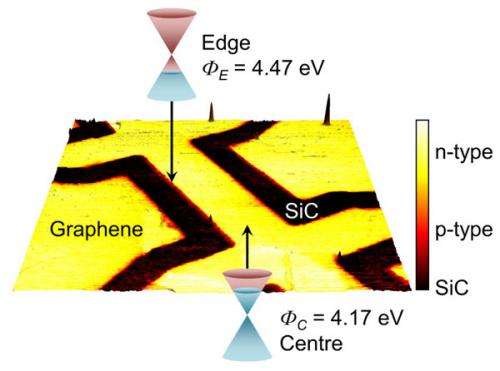On the edge of graphene

Researchers at the National Physical Laboratory (NPL) have discovered that the conductivity at the edges of graphene devices is different to the central material.
The group used local scanning electrical techniques to examine the local nanoscale electronic properties of epitaxial graphene, in particular the differences between the edges and central parts of graphene Hall bar devices. The research was published in Scientific Reports, an open access publication from Nature Publishing Group.
The researchers found that the central part of the graphene channel demonstrated electron conduction (n-doped), whereas the edges demonstrated hole conduction (p-doped). They were also able to precisely tune the conduction along the edges of the graphene devices using side-gates, without affecting the conductive properties at the centre.
At a smaller scale, these effects become more acute; when working at the submicron level, the altered properties may affect up to 25% of the material. Although both n- and p-type semiconductors conduct electricity, different types of conduction need to be acknowledged in the development of any devices. Graphene is increasingly used in the electronics industry and new devices will need to accommodate these differences.
The inversion effects were greatest just after the graphene had been cleaned, indicating that the carrier inversion was caused by defects at the channel edge introduced by the plasma etching process used to form the graphene devices. By contrast, a few hours after cleaning, the inversion effects were reduced as airborne molecules had adsorbed onto the uncoupled bonds at the edges of the graphene.
The results of this study are useful for developing graphene nanoribbon devices as well as for looking at edge photocurrents and the quantum Hall effect. The team is extending its work by investigating these effects in structurally different forms of graphene. In doing so, they will be able to compare different types of graphene and look more closely at the cause of these effects.
More information: Visualisation of edge effects in side- gated graphene nanodevices, www.nature.com/srep/2014/14073 … /full/srep05881.html
Journal information: Scientific Reports
Provided by National Physical Laboratory



















